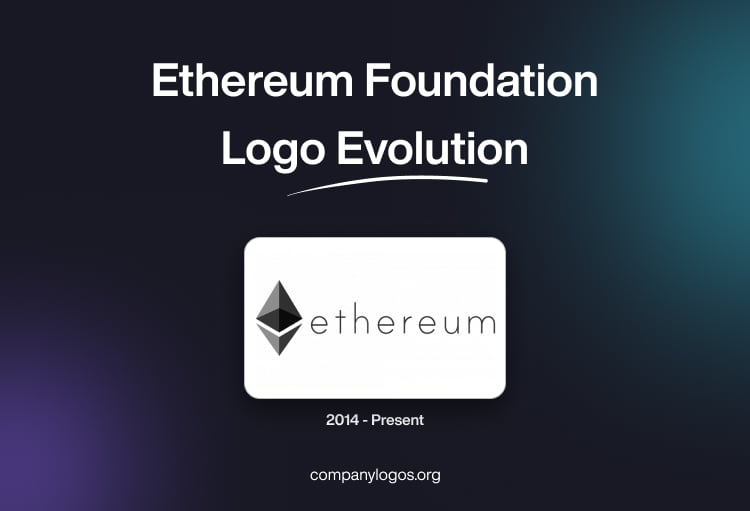
The Ethereum Foundation is a non-profit organization founded in 2014 with a mission to support and advance the Ethereum blockchain platform and its ecosystem. Based in Switzerland, the Foundation was founded by Vitalik Buterin, Gavin Wood, and Jeffrey Wilcke, among others. It was meant to oversee the development, research, and promotion of Ethereum, which is a decentralised, open-source blockchain platform enabling smart contracts and decentralised applications.
The Ethereum Foundation logo, comprising an iconic diamond-shaped symbol, is recognised throughout the blockchain world. It embodies Ethereum’s principles of decentralisation, innovation, and resilience.
The Genesis of the Ethereum Foundation (2014 – Present)
The Ethereum logo was created as a last-minute symbol by Vitalik Buterin and another founder. They used two mathematical summation signs (∑) rotated 45 degrees to produce a diamond- or crystal-like effect. After Ethereum’s initial coin offering (ICO), a special competition was held for a new logo design, which ultimately refined the original diamond motif and set the direction for Ethereum’s brand identity.
The emblem is based on an octahedron comprising six triangles. Four of these triangles are at the top and two at the bottom. The three-dimensional look of the emblem resembles a pyramid with faces in different shades. The lower part of the emblem appears to be the mirror image of the above, separated by a bent white strip aligned to the shape of the octahedron.
The emblem with many faces has the colours of black, grey, and white with various shades to symbolise clarity and the platform’s commitment to transparency and fairness. To the right of the emblem is the Ethereum wordmark in a dark grey colour and written using a Roboto sans-serif typeface developed by Google for the Android application.

The Elements of the Ethereum Foundation
Font
The wordmark that forms part of the Ethereum logo is written using a neo-grotesque Roboto sans-serif typeface. This was created by Google for the Android application, which, although it looks similar to classic symbology, is not used all across.
Colour
Ethereum has several regional variations to its logo based on the country. However, the basic colours of the emblem are grey, white, and black with different shades. The wordmark is rendered in a dark grey colour palette.
The History of the Ethereum Foundation
The Ethereum Foundation was established in Switzerland by Vitalik Buterin, Gavin Wood, and Jeffrey Wilcke. It was done soon after the envisioned Ethereum project was announced at the North American Bitcoin Conference in Miami in January 2014. The founders also included key early contributors such as Charles Hoskinson, Anthony Di Iorio, Joseph Lubin, Mihai Alisie, and Amir Chetrit. The organization was set up as a non-profit to emphasise the openness of Ethereum and to encourage the long-term integrity and growth of the platform.
To finance development, the Ethereum Foundation coordinated a public crowd sale, which was an initial coin offering (ICO) from July to September 2014. The ICO sold ether (ETH) in exchange for bitcoin and raised over $18 million to make it one of the most successful crowdfunding campaigns at that time. These funds supported rapid development of the platform and the release of a yellow paper specifying Ethereum’s technology. Also, it supported the building of multiple protocols.
The Ethereum network was officially launched on July 30, 2015, after several phases of testing. The launch introduced the “genesis block” of Ethereum, with the Foundation playing a central role in managing software releases. It coordinated developer activity and educated the growing user and developer community.
In 2016, the Foundation faced a major crisis with the “DAO hack”, which involved the loss of around $50 million in ETH due to vulnerabilities in a high-profile decentralised application. The event generated a contentious community debate which resulted in a hard fork of Ethereum into two blockchains: Ethereum (with funds restored to users) and Ethereum Classic (which maintained the original, unaltered ledger). The Foundation continued to support and oversee the main Ethereum chain.
Since its inception, the Ethereum Foundation has actively promoted the growth and adoption of Ethereum. It funded developer teams, research, and multiple upgrades, including the transition from proof-of-work to proof-of-stake. It remains a vital steward of the network’s ethos: decentralisation, permissionless innovation, and public good.
Interesting Facts About the Ethereum Foundation
- The Foundation was formally created in Switzerland on July 6, 2014, by Vitalik Buterin, Gavin Wood, and Jeffrey Wilcke. There was also a diverse group of early contributors from all over the world.
- The founding of the company was key to navigating both legal and operational obstacles. One of the early concerns was complying with crowdfunding regulations to avoid tax penalties on the $18 million raised in Ethereum’s 2014 ICO.
- Ethereum organised its first major developer event, Devcon-0, only months after its creation. It brought together many figures in crypto and set a tradition of annual developer conferences.
- The Foundation has built a strong community philosophy, which focused on technology as well as on creating conditions for the “fertile soil of consensus”. It nurtured experimentation and laid the groundwork for future innovators.
- Ethereum is famous for its long and sometimes contentious list of founders. It included Vitalik Buterin, Anthony Di Iorio, Charles Hoskinson, Mihai Alisie, and Amir Chetrit, with Joseph Lubin, Gavin Wood, and Jeffrey Wilcke added as founders in early 2014.
- The infamous 2016 DAO hack resulted in a $50 million theft. It pushed the Foundation and community to fork the chain and create Ethereum (ETH) and Ethereum Classic (ETC).
- After surviving this crisis, Ethereum cemented its legacy as a network capable of community consensus. This was even in periods of existential turmoil.
- The Foundation led Ethereum’s transition from energy-intensive proof-of-work to eco-friendly proof-of-stake in 2022, which was one of the largest events ever in blockchain history.
- Ethereum has had many major network upgrades (“hard forks”). One of these, called Altair, was the first to happen at an exact rollout time, rather than being tied to a block number.
- The Foundation is led by Aya Miyaguchi (Executive Director), with Vitalik Buterin and Patrick Storcheneger on its committee.
- Its mission remains supporting Ethereum as a public good to help millions of developers, entrepreneurs, and communities experiment with decentralised applications and shape the next era of the internet.
Finally
The Ethereum Foundation logo is a testament to trust, innovation, and the open-source movement. It continues to inspire both practical application and imaginative speculation throughout the blockchain world.